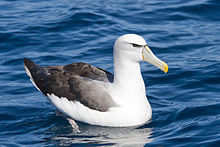| Aequornithes Temporal range: Early Paleocene–Holocene 62–0 Ma PreꞒ Ꞓ O S D C P T J K Pg N Possibly an earlier origin based on molecular clock | |
|---|---|

| |
| Shy albatross (Thalassarche cauta) | |
| Scientific classification | |
| Domain: | Eukaryota |
| Kingdom: | Animalia |
| Phylum: | Chordata |
| Class: | Aves |
| Clade: | Phaethoquornithes |
| Clade: | Aequornithes Mayr, 2010 |
| Clades | |
| |
Aequornithes (/iːkwɔːrˈnɪθiːz/, from Latin aequor, expanse of water + Greek ornithes, birds), or core water birds, are defined in the PhyloCode as "the least inclusive crown clade containing Pelecanus onocrotalus and Gavia immer".
The monophyly of the group is currently supported by several molecular phylogenetic studies.
Aequornithes includes the clades Gaviiformes, Sphenisciformes, Procellariiformes, Ciconiiformes, Suliformes and Pelecaniformes. It does not include several unrelated groups of aquatic birds such as flamingos and grebes (Mirandornithes), shorebirds, gulls, and auks (Charadriiformes), or the Anseriformes (waterfowl).
Based on a whole-genome analysis of the bird orders, the kagu and sunbittern (Eurypygiformes) and the three species of tropicbirds (Phaethontiformes) together styled as the Eurypygimorphae are the closest sister group of the Aequornithes, in a clade later named Phaethoquornithes.
Phylogeny
The cladogram below is based on Burleigh, J.G. et al. (2015) with some names after Sangster, G. & Mayr, G. (2021).
| Aequornithes |
| ||||||||||||||||||||||||||||||
The clade Feraequornithes was named by Sangster & Mayr, 2021 to include the Pelecanimorphae and Procellariimorphae to the exclusion of the loons (Gaviiformes). They defined this clade in the PhyloCode as "the least inclusive clade containing Pelecanus onocrotalus and Procellaria aequinoctialis".
References
- Slack, Kerryn E.; Jones, Craig M.; Ando, Tatsuro; Harrison, G.L. "Abby"; Fordyce, R. Ewan; Arnason, Ulfur; Penny, David (2006). "Early Penguin Fossils, plus Mitochondrial Genomes, Calibrate Avian Evolution". Molecular Biology and Evolution. 23 (#6): 1144–1155. CiteSeerX 10.1.1.113.4549. doi:10.1093/molbev/msj124. PMID 16533822. Supplementary Material Archived December 16, 2009, at the Wayback Machine
- Kuhl., H.; Frankl-Vilches, C.; Bakker, A.; Mayr, G.; Nikolaus, G.; Boerno, S. T.; Klages, S.; Timmermann, B.; Gahr, M. (2020). "An unbiased molecular approach using 3'-UTRs resolves the avian family-level tree of life". Molecular Biology and Evolution. 38: 108–127. doi:10.1093/molbev/msaa191. PMC 7783168. PMID 32781465.
- ^ Mayr, Gerald (2011). "Metaves, Mirandornithes, Strisores and other novelties – a critical review of the higher-level phylogeny of neornithine birds". Journal of Zoological Systematics and Evolutionary Research. 49 (1): 58–76. doi:10.1111/j.1439-0469.2010.00586.x.
- Sangster, G.; Braun, E.L.; Johansson, U.S.; Kimball, R.T.; Mayr, G.; Suh, A. (2022). "Phylogenetic definitions for 25 higher-level clade names of birds". Avian Research. 13: 100027. Bibcode:2022AvRes..1300027S. doi:10.1016/j.avrs.2022.100027.
- ^ Sangster, G.; Mayr, G. (2021). "Feraequornithes: a name for the clade formed by Procellariiformes, Sphenisciformes, Ciconiiformes, Suliformes and Pelecaniformes (Aves)". Vertebrate Zoology. 71: 49–53. doi:10.3897/vertebrate-zoology.71.e61728.
- ^ Jarvis, E.D.; et al. (12 December 2014). "Whole-genome analyses resolve early branches in the tree of life of modern birds". Science. 346 (6215): 1320–1331. Bibcode:2014Sci...346.1320J. doi:10.1126/science.1253451. PMC 4405904. PMID 25504713.
- Sangster, George; Braun, Edward L.; Johansson, Ulf S.; Kimball, Rebecca T.; Mayr, Gerald; Suh, Alexander (2022-01-01). "Phylogenetic definitions for 25 higher-level clade names of birds" (PDF). Avian Research. 13: 100027. Bibcode:2022AvRes..1300027S. doi:10.1016/j.avrs.2022.100027. ISSN 2053-7166.
- Hackett, S.J.; et al. (27 June 2008). "A phylogenomic study of birds reveals their evolutionary history". Science. 320 (5884): 1763–1768. Bibcode:2008Sci...320.1763H. doi:10.1126/science.1157704. PMID 18583609. S2CID 6472805.
- Yuri, T.; et al. (2013). "Parsimony and model-based analyses of indels in avian nuclear genes reveal congruent and incongruent phylogenetic signals". Biology. 2 (1): 419–444. doi:10.3390/biology2010419. PMC 4009869. PMID 24832669.
- Kimball, R.T.; et al. (December 2013). "Identifying localized biases in large datasets: A case study using the Avian Tree of Life". Mol Phylogenet Evol. 69 (3): 1021–32. Bibcode:2013MolPE..69.1021K. doi:10.1016/j.ympev.2013.05.029. PMID 23791948.
- Kuramoto, T.; et al. (2015). "Determining the Position of Storks on the Phylogenetic Tree of Waterbirds by Retroposon Insertion Analysis". Genome Biology and Evolution. 7 (12): 3180–3189. doi:10.1093/gbe/evv213. PMC 4700946. PMID 26527652.
- Sangster, George; Braun, Edward L.; Johansson, Ulf S.; Kimball, Rebecca T.; Mayr, Gerald; Suh, Alexander (2022). "Phylogenetic definitions for 25 higher-level clade names of birds". Avian Research. 13: 100027. Bibcode:2022AvRes..1300027S. doi:10.1016/j.avrs.2022.100027. S2CID 247988800.
- Burleigh, J.G.; et al. (March 2015). "Building the avian tree of life using a large-scale, sparse supermatrix". Molecular Phylogenetics and Evolution. 84: 53–63. Bibcode:2015MolPE..84...53B. doi:10.1016/j.ympev.2014.12.003. PMID 25550149.
| Taxon identifiers | |
|---|---|
| Aequornithes | |
